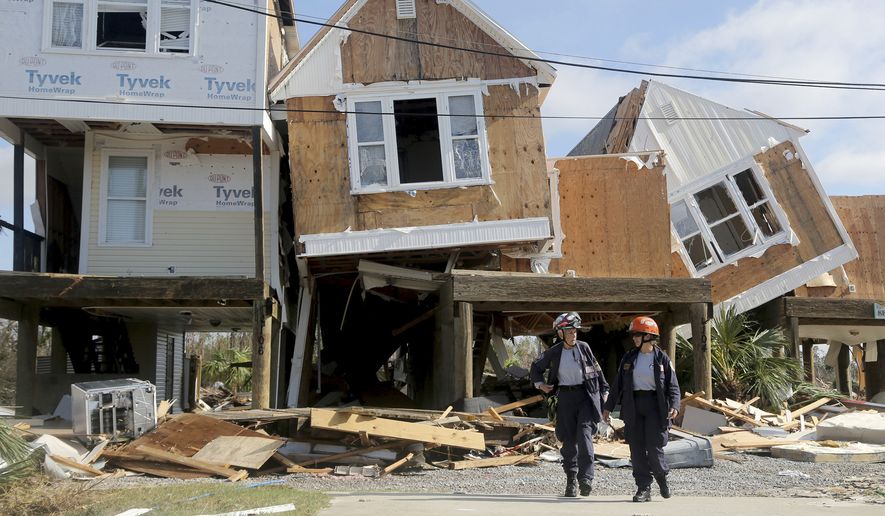As one of the strongest hurricanes ever to make U.S. landfall, Hurricane Michael wrecked extensive damage, but the theme emerging Thursday was that a combination of deft forecasting, quick emergency response, and a fortuitous path prevented the disaster from being much worse.
So far six people have been reported killed as Michael, downgraded to a tropical storm, raced across the Carolinas toward Virginia, a day after hitting the Florida panhandle Wednesday morning as a Category 4 hurricane with wind speeds of up to 155 mph.
The devastation to the tiny towns of Mexico City and Panama City Beach was enormous — one resident said it “looked like a bomb went off” — and yet the hurricane’s descent on a sparsely populated stretch of beach was credited with limiting the damage.
“It was kind of like a train coming through your neighborhood and we were watching trees fall and stuff like that,” said Franklin County Sheriff A.J. Smith. “It was scary, but it could have been a lot worse.”
President Trump described the hurricane as “unbelievably destructive and powerful,” contrasting it with last year’s Hurricane Harvey, which caused in 106 U.S. deaths and massive flooding as it drifted for a week between Texas and Louisiana.
“The big problem with this hurricane was the tremendous power, and fortunately it was very fast,” Mr. Trump told reporters the Oval Office. “It went through Florida very, very quickly, it didn’t linger, it didn’t come back, as we had in Texas.”
The skies cleared and the sun came out Thursday in the panhandle, allowing teams the National Guard, Coast Guard and first responders to conduct search-and-rescue efforts for any survivors trapped in the rubble.
Authorities said about 285 of Mexico Beach’s 1,000 residents failed to heed the mandatory evacuation order. Entire blocks were reduced to little more than concrete slabs after the powerful winds ripped house and buildings from their foundations.
Florida Gov. Rick Scott urged evacuees who fled the hardest-hit areas to stay put until crews can clear the bridges and roads, some of which were still flooded or clogged with fallen trees, power lines, branches and other wreckage.
“I know you just want to go home. You want to check on things, and begin the recovery process,” Mr. Scott said. “[But] we have to make sure things are safe.”
FEMA administrator Brock Long estimated the power outages from the storm affected between 500,000 and 600,000, which was fewer than he had anticipated, adding that it could be “multiple weeks” before electricity is restored to some homes.
“We were actually estimating about twice if not three times that amount being out as a result of the system,” said Mr. Long at a press conference. “That is some good news, but for those half-million people that don’t have power, we understand the frustration and we’re doing everything we can.”
Phil Klotzbach, Colorado Springs University meteorologist, ranked Hurricane Michael unofficially as the fourth strongest in U.S. history and third-strongest to hit Florida, as well as the most powerful hurricane to crash the Florida panhandle.
Ahead of Michael among U.S. hurricanes were the 1935 Labor Day hurricane, which left 485 dead; Hurricane Camille, which killed 259 people in 1969, and Hurricane Andrew in 1992, which resulted in 65 deaths, and. All three were Category 5 hurricanes.
Hurricane Michael came as a surprise to some. Unlike many storms, which form off the coast of Africa, Michael organized in the Caribbean, giving forecasters less time to track it before it made landfall.
Meteorologists at the National Weather Service, National Hurricane Center and elsewhere drew kudos for their quick and accurate work in tracking the hurricane.
“This was a success for modern technology,” said Roger A. Pielke Sr., University of Colorado Boulder meteorologist. “From satellite and radar monitoring, to computer models of track and intensity, and to dissemination of warnings by the NWS, private forecasters, the media, and local and national emergency managers, many lives were saved.”
State and local officials were praised for their relentless efforts to evacuate those in the hurricane’s path. About 375,000 people were under mandatory and voluntary evacuation orders, although not all complied.
Sheriff Smith said the 12,000 residents of Franklin County received evacuation warnings from multiple sources, including Mr. Scott.
“I think that we had an exceptionally high rate of evacuees because we had the message, we kept putting it out,” Sheriff Smith told Fox’s “Your World with Neil Cavuto.” “The EOC [emergency operations center] came, and the sheriff’s office, and then the governor was here and talked about it again, and then the day before, we sent deputies in the low-lying areas door to door to tell people.”
Meteorologist Bill Steffen described the casualty rate in the aftermath of such a massive storm as a credit to all involved.
“The low loss of life and injury total is an awesome testament to the early, accurate forecasts on the track of the storm and the vast majority of people heeding the warnings and moving to safe shelter,” tweeted Mr. Steffen. “NWS/NASA efforts here well worth the taxes paid to support this effort.”
Ken Widelski, NOAA/NWS emergency-response meteorologist, said the storm presented a risk of more flooding for communities in South Carolina and North Carolina still recovering from Hurricane Florence, which made landfall last month as a Category 1 storm but soaked the area after stalling for several days.
“We’re looking at widespread moderate to locally major river flooding to once again resurface over North Carolina likely beginning today, continuing for the next several days,” Mr. Widelski said.
He said Michael is expected to exit land and blow into the Atlantic Ocean sometime Friday.
“Fortunately, the system is moving rather quickly,” said Mr. Widelski. “So it will be off the coast tomorrow, so we don’t expect this flooding to hang around as long as it did during Florence.”
• The Associated Press contributed to this report.
• Valerie Richardson can be reached at vrichardson@washingtontimes.com.




Please read our comment policy before commenting.